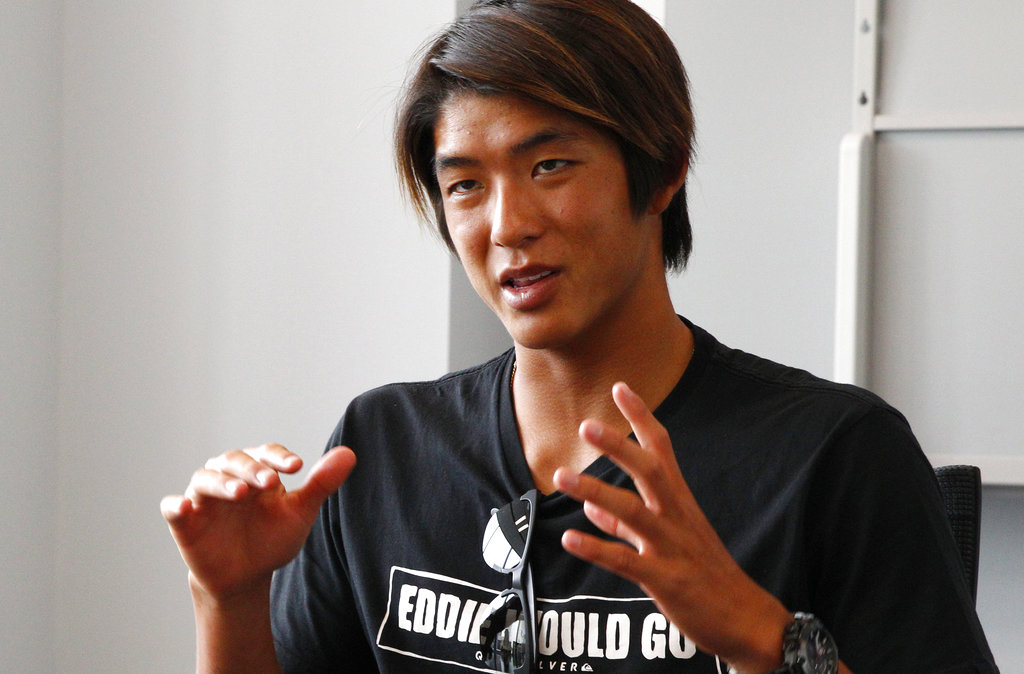
In this June 8, 2018 photo, surfer Kanoa Igarashi talks about his his preparations for the 2020 Tokyo Olympics where surfing will make its Olympic debut during an interview in Tokyo. In keeping with the best laid-back traditions of his sport, Igarashi isn’t about to let the pressure of representing Japan overwhelm him when surfing makes its much-anticipated debut at the 2020 Tokyo Olympics. The 20-year-old Igarashi was born in Huntington Beach, California, in 1997 but recently received Japanese citizenship in order to compete for is ancestral homeland in 2020. (AP Photo/Nicola Shannon)
TOKYO — In keeping with the laid-back lifestyle of his sport, Kanoa Igarashi won’t let the pressure of representing Japan overwhelm him when surfing makes its much-anticipated debut at the 2020 Tokyo Olympics.
The 20-year-old Igarashi was born in Huntington Beach, California, in 1997 but recently received dual citizenship in order to compete for his ancestral homeland in 2020.
“Ever since I was a kid, I loved being in the spotlight,” Igarashi said during a recent interview. “I loved having a lot of people watching me and competing under high pressure situations.”
In April, The International Surfing Association formally approved Igarashi’s request to represent Japan at future ISA World Championships. Igarashi previously represented the United States.
As host nation, Japan automatically receives one slot for the men’s and women’s event. As the first Japanese surfer on the World Tour, Igarashi will be a strong favorite to represent his country in the Olympics.
Igarashi’s father Tsutomu grew up surfing in Japan before moving to the United States.
Kanoa started surfing at the age of three and entered his first contest three years later. He qualified for the World Surf League’s championship tour in 2015 and, one year later as an 18-year-old rookie, collected more Round One wins than any surfer on the tour that year.
The chance to represent Japan is a dream come true for Igarashi.
“It’s everything I’ve dreamt of as a kid, especially with the Olympics coming up,” Igarashi said. “It’s all happening, this is a really big moment in my career and I’m going to remember it for the rest of my life.”
The surfing competition in 2020 will be held at the Tsurigasaki beach in Chiba Prefecture, about two hours outside of the Japanese capital. It’s where Igarashi’s father honed his skills before moving to the US.
While the waves at Tsurigasaki can’t rival those of the North Shore of Oahu, Igarashi said there are plenty of challenges.
“It’s up to us to find the ideal wave,” Igarashi said. “That’s part of the challenge.”
The four-man heat method will be used. Four athletes will compete at a time, with the best two proceeding to the next round. The length of a heat depends on the condition of the waves and lasts 20 to 25 minutes. In that time, an athlete can ride 10 to 12 waves, with their two highest scores counting.
The United States, Australia and Brazil are expected to be the favorites but given his experience and familiarity with the waters, nobody is counting Igarashi out.
“It’s not just about me,” Igarashi said. “It’s about my whole country that is backing me and behind me and supporting me. I can’t wait for the moment to come and I’m going to do my best to prepare for it mentally and physically to get the gold medal.”
The International Surfing Association, based in La Jolla, California, is the sport’s governing body. It was founded in 1964.
Surfing’s push to be included in the Olympics has a long history but got a big boost in 2014 when IOC President Thomas Bach realized the need to add more youthful, vibrant sports to the Olympic program.
A total of 26 sports applied for inclusion in the 2020 Games and in August of 2016, five new sports, including surfing, were added to the program.
Despite his relaxed approach, Igarashi knows competing for Japan in home waters on sport’s biggest stage will be a once-in-a-lifetime opportunity.
“This is the Olympics, this is the 2020 Olympics in Tokyo. It’s not just another test in school, this is the real deal,” Igarashi said. “I feel the pressure every day. I go to sleep thinking about it but this is what makes a great athlete, it’s about dealing with the pressure, being excited for the moment instead of being scared of the pressure.”